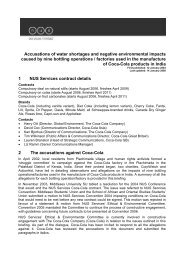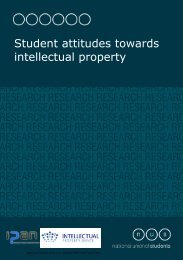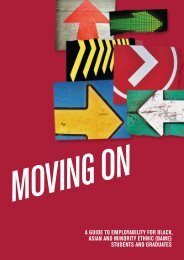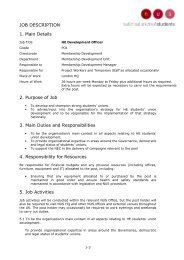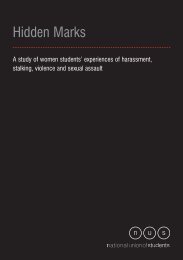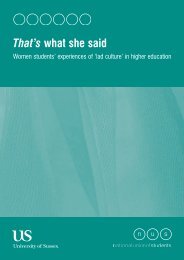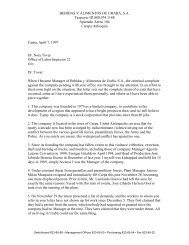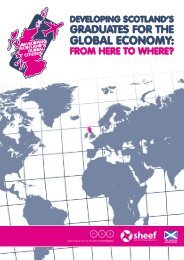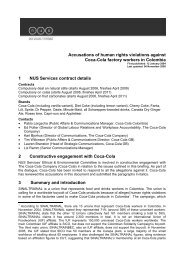No Place for Hate Crime - National Union of Students
No Place for Hate Crime - National Union of Students
No Place for Hate Crime - National Union of Students
You also want an ePaper? Increase the reach of your titles
YUMPU automatically turns print PDFs into web optimized ePapers that Google loves.
<strong>No</strong> <strong>Place</strong> <strong>for</strong> <strong>Hate</strong><br />
incident <strong>of</strong> physical abuse. In comparison, only 14 per<br />
cent <strong>of</strong> heterosexuals and 12 per cent <strong>of</strong> those who<br />
preferred not to say indicated they had experienced<br />
one or more <strong>for</strong>ms <strong>of</strong> physical abuse while studying at<br />
their institution.<br />
Nine per cent <strong>of</strong> gay respondents experienced at least<br />
one <strong>for</strong>m <strong>of</strong> serious physical abuse – at least double<br />
that <strong>of</strong> respondents identifying as heterosexual, lesbian<br />
or who preferred not to say. Eight per cent <strong>of</strong> bisexual<br />
respondents and the same percentage <strong>of</strong> students<br />
identifying as an ‘other’ sexual orientation also reported<br />
at least once incident <strong>of</strong> serious physical abuse.<br />
Prejudice against gender identity<br />
Eight (20 per cent) students self-identifying as trans<br />
or with a trans background reported at least one<br />
instance <strong>of</strong> physical abuse at least partly motivated by<br />
a prejudice against their gender identity while studying<br />
at their current institution. This compares with only 5<br />
per cent <strong>of</strong> respondents who preferred not to disclose<br />
their gender identity and 6 per cent <strong>of</strong> students with the<br />
same gender identity as assigned at birth.<br />
Severity and injuries<br />
Fifty per cent <strong>of</strong> incidents involving physical abuse<br />
motivated by prejudice against the victim’s gender<br />
identity (whether they were trans or cisgender) entailed<br />
being subjected to unwanted sexual contact. One in<br />
five also involved the victim being followed or chased.<br />
Less common experiences included being held down<br />
or physically blocked, being pushed, slapped, shoved<br />
or having their hair pulled and having something thrown<br />
at them that could cause injury.<br />
Analysis <strong>of</strong> the qualitative data gathered from many<br />
<strong>of</strong> the cisgender respondents reporting an incident<br />
<strong>of</strong> physical abuse because <strong>of</strong> a bias against their<br />
gender identity implies that many <strong>of</strong> these students<br />
experienced sexist behaviour. Tellingly, the vast<br />
majority <strong>of</strong> these respondents were women, indicating<br />
that violence against women is a real and serious<br />
concern among students. 19 However, because not all<br />
respondents provided further in<strong>for</strong>mation about their<br />
experiences we were not able to fully discern which<br />
incidents were related to sexist prejudice and violence<br />
against women.<br />
Of the eight trans respondents reporting incidents<br />
<strong>of</strong> physical abuse they believed to be transphobic,<br />
six reported experiences involving being followed,<br />
chased, held down or physically blocked. The other<br />
two respondents reported incidents <strong>of</strong> transphobic<br />
physical abuse involving more serious experiences,<br />
both <strong>of</strong> which resulted in injuries. One <strong>of</strong> these students<br />
reported being kicked, bitten or hit and choked,<br />
dragged, strangled or burned. This incident resulted<br />
in severe bruising, a broken nose, a concussion/loss<br />
<strong>of</strong> consciousness, and caused them to seek medical<br />
treatment <strong>for</strong> their injuries. Another trans student<br />
reported several instances in which they were pushed,<br />
slapped, shoved or had their hair pulled, causing minor<br />
bruising. Three trans respondents additionally reported<br />
having been subjected to unwanted sexual contact on<br />
several occasions.<br />
Vandalism, property damage and theft<br />
Fifteen per cent (1,337) <strong>of</strong> all respondents had<br />
experienced at least one <strong>of</strong> the following while studying<br />
at their institution:<br />
• vandalism – someone deliberately defacing or doing<br />
damage to their house, flat or halls <strong>of</strong> residence, or<br />
anything outside it<br />
• property damage – someone deliberately damaging,<br />
tampering with or vandalising their property (eg<br />
personal belongings, vehicle, bicycle or other<br />
property)<br />
• personal theft – personal belongings stolen from their<br />
hands, bag, pockets or locker<br />
• personal theft outside their home – eg from their<br />
doorstep, garden or garage<br />
• robbery – someone taking or attempting to take<br />
something by <strong>for</strong>ce or threat <strong>of</strong> <strong>for</strong>ce<br />
• burglary – someone illegally entering their residence<br />
to steal or attempting to steal their belongings, inflict<br />
bodily harm or cause criminal damage.<br />
24



